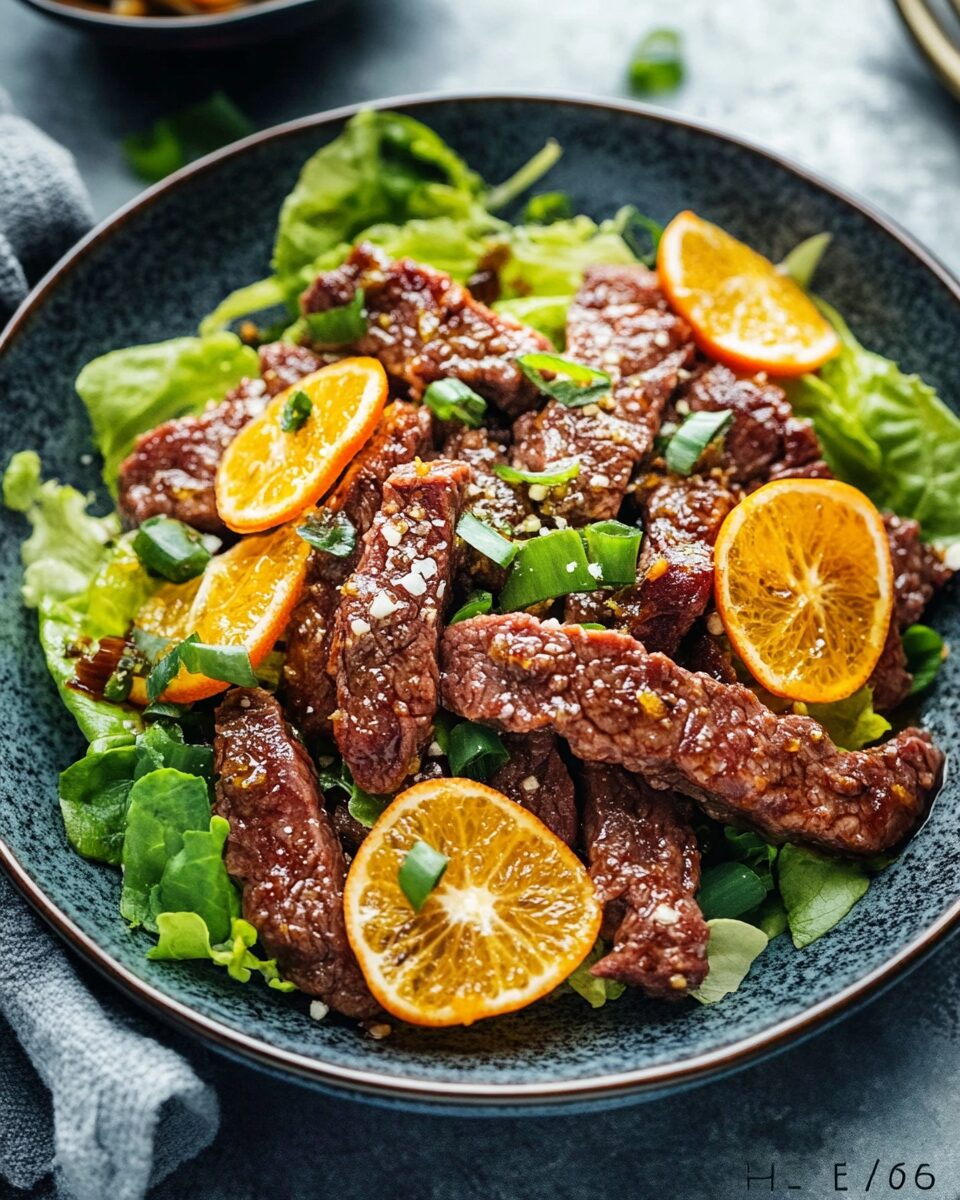This Crispy Orange Beef brings the vibrant flavor of Chinese takeout straight to your home kitchen — no deep-frying required. The magic lies in the technique: a quick marination with baking soda tenderizes even the cheapest cuts of beef, while a light cornstarch coating creates a perfectly crisp exterior when seared in a hot pan.
The orange sauce is a harmony of tangy, sweet, and savory flavors. Freshly squeezed orange juice and zest give the dish a bright citrus punch, while soy sauce and rice vinegar add depth and balance. Whether you’re cooking for guests or just treating yourself, this dish is a flavorful, quick-cooking favorite you’ll want on repeat.
Full Recipe:
-
1 lb (450 g) flank steak or other tender cuts, sliced into 1/4” strips against the grain
-
2 tablespoons Shaoxing wine (or dry sherry for gluten-free)
-
1/2 teaspoon salt
-
1/2 teaspoon baking soda
-
1/4 cup cornstarch
Sauce:
-
1 tablespoon orange zest (from 1 large orange)
-
1/2 cup fresh orange juice
-
3 tablespoons rice vinegar
-
1 tablespoon light soy sauce (or tamari for gluten-free)
-
2 tablespoons sugar
-
1 tablespoon cornstarch
Stir Fry:
-
1/4 to 1/3 cup peanut oil or vegetable oil
-
1 teaspoon fresh ginger, minced
-
3 cloves garlic, minced
-
2 green onions, sliced (white and green parts separated)
Directions:
-
In a large bowl, combine the sliced beef with Shaoxing wine, salt, and baking soda. Mix well and marinate for 30 minutes.
-
While beef marinates, prepare the sauce by whisking all sauce ingredients until smooth. Set aside.
-
Coat the marinated beef with cornstarch evenly just before cooking.
-
Heat oil in a large skillet or wok over high heat. Cook beef in batches without overcrowding the pan. Sear until golden brown, about 1 minute per side. Remove and set aside.
-
Reduce heat slightly and remove excess oil, leaving about 1 tablespoon. Add ginger, garlic, and white parts of the green onion. Stir-fry for 30 seconds until fragrant.
-
Stir the sauce again and pour into the pan. Cook until thickened, about 30 seconds.
-
Return beef to the pan, toss to coat with sauce, then turn off heat. Garnish with green onion tops and serve hot over steamed rice.
Prep Time: 20 minutes | Cooking Time: 10 minutes | Total Time: 1 hour (including marination)
Kcal: 315 kcal | Servings: 4
The Allure of Orange Beef: A Crispy, Citrus-Savory Chinese Favorite
Orange Beef is a dish that embodies the essence of Chinese-American cuisine — bold flavors, crisp textures, and an irresistible balance between tangy sweetness and savory depth. While Orange Chicken has long dominated takeout menus, Orange Beef offers a richer, meatier twist on the citrus-forward classic. The dish is both nostalgic and exciting, reminiscent of restaurant-style stir fries yet refreshed with modern cooking techniques that make it healthier and more accessible at home.
This particular recipe elevates Orange Beef by removing the need for deep-frying, relying instead on clever preparation methods like baking soda marination and searing. The result is tender beef strips with an addictively crispy exterior, drenched in a glossy orange sauce that bursts with zest, freshness, and umami. Whether you’re a fan of Chinese food or exploring new ways to cook beef, this dish delivers both comfort and culinary excitement.
Origins and Evolution of Orange Beef
Orange Beef doesn’t come from traditional Chinese cuisine per se. Like General Tso’s Chicken or Mongolian Beef, it’s a product of Chinese-American culinary evolution. Dishes like these were born in the kitchens of immigrants who adapted flavors and techniques from home to suit American palates and available ingredients.
The earliest iterations of Orange Beef likely emerged from Chinese restaurants in North America during the mid-to-late 20th century. Chefs used common ingredients like soy sauce, sugar, garlic, and citrus to mimic the sweet-and-savory profiles that Western diners enjoyed. Over time, the dish became a staple of takeout culture, cementing itself as a crowd-pleasing favorite — often overshadowed by its poultry-based cousin, Orange Chicken.
What makes the modern Orange Beef stand out is its use of fresh orange juice and zest, which gives the dish brightness without excessive sweetness. This version also swaps out deep frying for a skillet-sear technique, significantly reducing oil usage without sacrificing texture or flavor.
Why Baking Soda is a Game-Changer in This Recipe
One of the most innovative techniques in this Orange Beef recipe is the use of baking soda during marination. This method is inspired by traditional Chinese “velveting” — a process used to keep meat tender during high-heat cooking.
Baking soda alters the pH of the meat’s surface, preventing proteins from binding too tightly when heated. This creates a juicier, more tender result, especially important when cooking beef quickly at high temperatures. Even lean or less expensive cuts like round roast or fajita steak can come out with a succulent texture, making this dish both gourmet and budget-friendly.
It’s crucial, however, not to overdo the baking soda. Used in the right amount and given enough resting time (typically 30 minutes), it enhances the meat without imparting an off flavor. This small adjustment can be the difference between chewy and melt-in-your-mouth beef.
Achieving Crispiness Without Deep Frying
Traditional Orange Beef is often deep fried, which gives it its signature crispy coating. However, this recipe cleverly sidesteps the need for deep oil immersion by using just enough oil to coat the pan and frying the beef in small batches. The result is a golden, crisp crust thanks to the cornstarch coating and hot oil contact, all without the heaviness of a deep fry.
This makes the dish not only healthier but more accessible for home cooks. You don’t need a fryer or a gallon of oil — just a nonstick skillet or wok, some patience with batch cooking, and attention to temperature. By keeping the heat high and flipping quickly, you retain moisture inside while developing crunch on the outside.
Letting the cooked beef rest before adding it to the sauce is another clever step. It prevents sogginess and allows the coating to set further, ensuring a satisfying texture with every bite.
Balancing Flavors in the Orange Sauce
The sauce is what brings everything together — a vibrant, slightly thick glaze that coats the beef like a citrusy hug. Fresh orange zest and juice provide that unmistakable brightness, while rice vinegar and soy sauce add the acidic and salty counterpoints. A bit of sugar rounds out the tang and enhances caramelization during the final stir.
What’s brilliant about this sauce is its adaptability. You can increase the sugar for a sweeter profile or add chili paste for a spicy kick. Tamari can replace soy sauce for a gluten-free option, and the vinegar can be adjusted based on what you have on hand — even apple cider vinegar works in a pinch.
Because the sauce thickens quickly, it’s essential to have it fully mixed before pouring it into the pan. Once it hits the heat, the cornstarch activates and transforms it into that luscious glaze that makes Orange Beef so visually and gastronomically appealing.
Pairing Ideas and How to Serve
Orange Beef is a stand-alone star, but it truly shines when paired with a few thoughtfully chosen side dishes. Classic steamed jasmine rice is the traditional and most effective companion — it soaks up the sauce while providing a neutral contrast to the rich, tangy beef.
If you’re looking to round out the meal, here are a few ideas:
-
Stir-fried green beans or broccoli: Their crunch and slight bitterness complement the sweetness of the beef.
-
Egg fried rice: A richer alternative to plain rice, ideal for more indulgent meals.
-
Cucumber salad: Light and refreshing, it acts as a palate cleanser.
-
Egg rolls or spring rolls: Perfect for texture contrast and making it a full takeout-style experience.
-
Soup starters like hot & sour soup or egg drop soup: These bring warmth and variety to the table.
This dish also holds up well in lunchboxes and reheats beautifully, making it a favorite for meal prepping or next-day leftovers. The flavors meld even further overnight, and the sauce can be refreshed with a splash of hot water or orange juice.
Tips for Home Cooks and Customizations
One of the best aspects of this Orange Beef recipe is how flexible it is. Here are some customization options and tips for ensuring success:
Advertisement
-
Protein swaps: You can use pork, chicken, or even tofu with the same sauce and preparation technique. Just adjust cooking times based on the protein.
-
Vegetable additions: Try adding bell peppers, snow peas, or onions to bulk up the dish with more veggies.
-
Spice it up: Add crushed red pepper flakes, chili oil, or Sriracha for a spicy twist.
-
Citrus alternatives: While orange is classic, blood orange or even grapefruit zest can introduce unique notes for a gourmet version.
-
Low-sugar modification: Reduce the sugar or substitute with honey or monk fruit sweetener for a diabetic-friendly variation.
A Healthier, Smarter Take on a Classic
What sets this version of Orange Beef apart is its smart approach to technique and flavor. It doesn’t cut corners — it cuts grease. By replacing deep frying with pan searing, using baking soda to tenderize, and emphasizing fresh ingredients, the dish becomes something you can feel good about serving again and again.
This is a perfect example of how home cooking can rival (and even exceed) takeout, especially when you understand the methods behind the meal. Once you try this Orange Beef, you’ll realize that restaurant flavor isn’t exclusive to restaurants.
Conclusion: A Crowd-Pleaser Worth Mastering
Whether you’re hosting a dinner party, prepping a midweek meal, or just craving something exciting, Orange Beef is a recipe worth keeping in your regular rotation. It’s easy enough for weeknights but special enough to impress guests. The combination of citrus, savory beef, and crisp textures creates a satisfying, well-rounded dish that hits all the right notes.
And the best part? You’re in full control. From tweaking the sweetness to adjusting the protein, this recipe is endlessly customizable. Master it once, and you’ll never need to rely on takeout menus again. Instead, you’ll serve up a dish that’s healthier, fresher, and made exactly to your taste — all from the comfort of your own kitchen.






